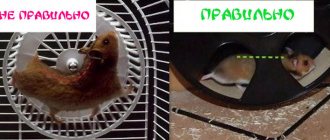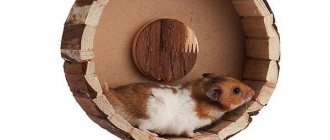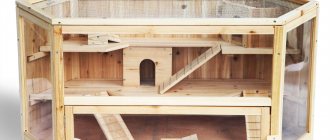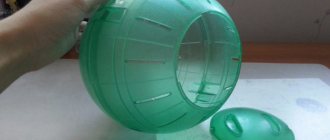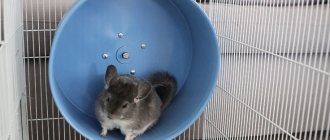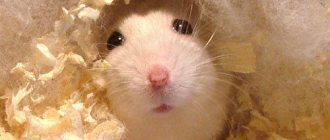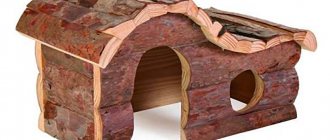It has long been noted that the hamster's favorite toy is the running wheel. Little furry needs it not only as entertainment, but also as a universal exercise machine for maintaining muscle tone. A running wheel for a hamster is bought in specialized stores for animals. But it happens that you come to the store and your eyes widen - that’s how many hamster rides there are! We will tell you how to choose the best toy for your pet that matches its breed and size.
Why do hamsters love running on wheels?
Once in captivity, the hamster no longer needs to worry about food, and its living space becomes limited.
A walking option with such a pet is not suitable, because the animal is small and is hunted by a large number of animals: domestic and wild. And if you do not provide him with additional physical activity, then the rodent will develop health problems: obesity, disruptions in the cardiovascular system, slower metabolism, and decreased muscle tone.
In addition, without entertainment, the animal falls into the blues, becomes lethargic and sad.
Varieties of homemade exercise equipment for hamsters
When making a hamster simulator, you need to immediately think through all the options: determine the dimensions, installation, choose the material. It should be comfortable for the pet and not injure it when running.
By diameter
You should choose the diameter of the circle, paying attention to the dimensions of the animal.
A drum that is too tight creates inconvenience for the hamster, because when running it has to bend strongly, which leads to curvature of the spine.
But if the animal is too wide, it will be difficult for him to spin, and he will soon abandon such an attraction.
According to manufacturing materials
A running wheel for your pet can be assembled from scrap materials. Wood, cardboard, plastic or a tin can are most often used. Since a hamster is a rodent, the design should not contain toxic substances: paint, varnish, etc.
By mounting method
Hamster wheels are attached in various ways:
- On the wall or bars of the cage. This installation saves space, but it has a negative side. During operation, the simulator touches the cage and makes noise. And since hamsters do not sleep at night, this creates inconvenience for the owners of the animal.
- To the bottom of the cage. This type of mount is unstable. The structure can turn over with the hamster.
- On a stand. The most convenient way. The simulator secured in this way produces little noise during operation and is securely mounted. However, it takes up a lot of space.
Which simulator to choose depending on the type of animal
When choosing the size of the product, it is worth considering the breed of hamsters. For the Djungarian hamster, it is better to choose a small wheel. Its diameter should be 14-16 cm.
The Syrian hamster will need a large trainer. Its diameter should not be less than 18 cm. It is better if it is 20-24 cm.
The width of the track also matters. For the Djungrik, the width of the device should be 5 cm, and for the Syrian - 7 cm. If the path is too narrow, the animal may fall off the simulator.
Requirements for a rodent trainer
To ensure that the hamster feels comfortable and its owners do not experience inconvenience from the sound of the wheel hitting the cage, the design nuances should be comprehensively considered.
To install a successful simulator you need to:
- its diameter corresponded to the size of the animal;
- the width of the treadmill was optimal for the animal’s paws;
- the attachment of the wheel to the axle was strong and at the same time movable, it turned easily;
- the accessory did not make noise;
- The running surface was comfortable.
From plastic bottles
It’s worth saying right away that building a maze for a hamster from plastic bottles is more difficult than from a construction set - here a child cannot do without the help of an adult.
To work, you will need a sharp utility knife and plastic bottles. Their number can be either half a dozen or fifty. The more bottles, the longer and more interesting the labyrinth you can build.
If a hamster can be released into the labyrinths described above only under the supervision of the owner, then he can spend whole days in the bottle labyrinth. Perhaps he will be no less comfortable here than in his usual cage. And there will be much more space for physical exercise. True, a large labyrinth will take up quite a lot of space - also take this into account when starting work.
Having a sufficient amount of material, you can begin construction:
- Take two bottles. In one of them, on opposite walls, make two holes - a large one and a small one. One should correspond to the diameter of the bottle neck, and the second should correspond to the diameter of the bottle.
- Also make a hole near the neck of the second bottle so that the hamster can easily crawl through. Carefully process the edges - there should be no burrs or sharp surfaces here so that the rodent does not get injured during play.
- From the second bottle, unscrew the cap and insert the neck through the large hole, and then through the small one.
- Replace the cap of the second bottle.
Now you have a short maze consisting of two bottles. A hamster placed in one of them will be able to freely make its way into the second; all that remains is to lengthen the labyrinth to the size that seems optimal to you.
When making a labyrinth from plastic bottles, do not forget to make at least several holes in each bottle - it is best to use a thick awl or a hot nail here. Thanks to these holes, the air will be renewed, and your hamster will definitely not suffocate during his morning run.
You can create several spacious areas in the maze using five-liter water bottles. Place a small wheel in one, equip a drinking bowl and feeder in another, a house in the third, and so on. As a result, you will get not just a homemade maze for your hamster, but a full-fledged house with a treadmill.
What you need to know when making a running wheel
It’s easier to buy an accessory for a pet in a store, but making a hamster wheel with your own hands is more interesting. You just need to know the parameters and choose the material.
Optimal diameter
The diameter of the simulator’s circumference must be selected individually, depending on the age and breed of the rodent.
If a Djungarian hamster (adult) requires a diameter of 14–15 cm, then for a young one 12 cm is suitable. But when the animal grows up, the accessory should be changed to a more spacious one.
The Syrian hamster needs more space - 18 cm.
Dwarf rodent breeds easily fit in a drum with a diameter of 10 cm.
Material selection
A wooden trainer is more difficult to make, but it is more durable and safer if an animal starts to chew on it. In addition, this design is quieter and looks more aesthetically pleasing.
The metal frame is also not bad, but with prolonged use it soon begins to creak. And the running surface requires additional treatment.
A cardboard structure is assembled faster, but does not last long. Thick corrugated cardboard is used for it. It is convenient for a rodent to run along its surface, clinging with its paws. Since the simulator is lightweight, it is suitable for small breeds of hamsters or young individuals.
A wooden exercise machine will last longer.
Wheel surface
The width of the running surface should also correspond to the size of the pet. For an adult, 7 cm is needed. For dwarf breeds, 5 cm is enough. If the width is made smaller, the rodent will fall from the simulator. If it is more, he will not have enough strength to spin the drum.
The inner surface is made ribbed so that when running the hamster clings to its paws. Therefore, if the cylinder is made of metal or plastic, it is covered with fleecy cloth or pasted over with wooden inserts.
The use of lattice material for the inner surface is also acceptable, but the cells should not be large so that the animal’s paws do not fall into them.
And it is necessary to ensure that there are no extra bumps or gaps on the treadmill, which could cause a fall or injury.
Is it possible to make them yourself?
You can make tunnels and labyrinths yourself. The simplest, one might say, budget option for such a hole is a construction made of cardboard. Of course, it cannot be used constantly; sooner or later, it will have to be renewed or replaced altogether. Due to the availability of the material, this is actually not critical.
In addition, making a cardboard tunnel with your own hands is a wonderful joint activity for adults and small family members. There are no limits to children's imagination; adults only need to correct their work, imperceptibly correct it and direct it towards creating a cozy mink that is truly acceptable for pets. Children eagerly decorate the building
It is important to ensure that you do not use decorations that are dangerous for rodents, such as rhinestones, and you will also have to exclude some adhesives
The main advantage of such a homemade labyrinth will be its uniqueness. With some experience, you can create replaceable modules that can be periodically replaced or rearranged; this will eliminate habituation, and the pet will constantly explore the proposed structure, which will bring him great pleasure.
The material for creating the labyrinth will be boxes made of thick cardboard, for example, shoe boxes. The set of necessary tools is not so wide: scissors, ruler, compass, pencil, glue or tape.
The largest box can become the basis of a labyrinth. You can draw a plan on its inner surface. The side walls will become its walls. Various kinds of partitions are made from the material of smaller boxes; passages in the form of round holes need to be arranged in them at different but accessible levels for the animal. Inside individual “rooms” various ladders, cubes, and dead-end chambers can be arranged.
The boxes can be combined with tubes, such as toilet paper rolls. Thus, a structure with various passages and chambers can be created in which the pet can spend several hours a day.
Craftsmen build tunnels and labyrinths even from plastic bottles. However, this material has a significant drawback - it is very slippery. Rodent claws cannot cling to a plastic surface, so it is better to combine bottles with a cardboard or plywood base. Bottles can be cut in half and mounted on a rougher surface. If a multi-level hole is not intended, the bottles can be securely connected using tape. One of the undeniable advantages of such a labyrinth is transparency.
PVC plumbing pipes offer the widest scope for imagination and at the same time reliable execution; a wide variety of connections will allow you to create masterpiece structures. It is necessary to make small holes in the walls of such tunnels for ventilation. The tightness of their connections can cause discomfort for rodents.
The basic rules for creating artificial labyrinths are quite simple, there are not many of them.
- Moderation. Overloading the elements of the labyrinth will quickly tire the explorer and he will lose interest.
- Safety. The use of toxic adhesives is unacceptable. The hamster will definitely try out the labyrinth design. It is also advisable to protect it from contact with tape.
- Availability for observation. The animal, while in the maze, should not disappear from the owner’s field of vision. All its movements must be observable, and the owner must always imagine where the pet is currently located. Some hamsters are prone to escape, it can be difficult to get them back, and in the process of being “AWOL” they are exposed to serious dangers.
To learn how to make a tunnel for a hamster from plastic bottles, see below.
Instructions for making a homemade hamster wheel
There are simple instructions to help beginners build their own pet accessory. A homemade wheel does not require large financial costs and does not take much time to manufacture.
Made of wood
This version of a wheel made of plywood and wooden ice cream sticks:
- on a sheet of thin plywood, draw a circle of the required diameter;
- inside the first circle, draw a second one from the same center, but with a diameter 1 cm smaller;
- cut out 2 circles along the lines with a jigsaw so that you get a disk and a ring;
- drill a hole for fastening in the center of the disk;
- cut slots along the edges of the disk for sticks that will serve as a running track;
- cut the ice cream sticks to the required width of the track, taking into account the attachment to the disk and ring;
- Using non-toxic glue, connect the disk, sticks and ring;
- fasten the center of the fastening with a nut and screw to the wall of the cage firmly and movably.
You can secure the drum of the structure using a bearing from an old hard drive, and replace the ice cream sticks with bamboo wallpaper.
From tin cans
For such a wheel you will need a tin container of the required diameter. Its production requires less time.
To do this you should:
- cut the selected container to a height equal to the width of the treadmill;
- drill the center for fastening;
- sand the edges with sandpaper or tape;
- screw the wheel to the cage or use a bearing from an old hard drive.
A drum of this design should be securely fastened and rotate easily without making unnecessary noise.
Be sure to sand the edges.
From cardboard
A cardboard wheel is the simplest option.
On thick corrugated cardboard, draw:
- 2 circles of the required diameter;
- 2 parts for a trapezoidal stand;
- 1 strip, which matches the length and width of a treadmill.
Inside both circles, using a stationery knife, cut holes through which the animal will get inside the wheel. Glue the strip together to form a ring and connect it to 2 circles.
Use a spoke to secure both sides of the wheel together. Attach the parts for the stand along the edges.
Step-by-step instructions: how to make a labyrinth?
From plastic bottles
Now we’ll learn how to make a maze for a hamster with your own hands from plastic bottles. As it turns out, they can be used to make a whole gallery of multi-level tunnels. The configuration of the labyrinth can be simple, or with dead ends, and even multi-level. For the simplest play structure with 2 knees you will need 3 plastic bottles. Conventionally, they can be designated as:
- Entrance corridor.
- Passage corridor.
- Dead end.
You need to wash the bottles and remove the stickers from them. Cut off the bottom of the inlet bottle. Through this hole the hamster will enter the maze from his cage. The cut line should be free of notches and burrs. Cover the cut with electrical tape or tape so that the sharp edges do not injure the nimble animal.
In the part of the bottle where the narrowing towards the neck begins, 2 holes are cut out opposite each other with scissors: a small hole with a diameter slightly larger than the cap and a large one, almost equal to the diameter of the bottle. To cut a circle, first use a knife to make a cross-shaped slot into which you can easily insert scissors.
In the tapering part of the second - passage - bottle, make a round hole smaller than the diameter of the bottle. Cover the edges of all cuts with tape or tape.
Insert a pass-through bottle through the large hole so that the cap comes out the other side. The parts should form the letter “G” or, in other words, a knee. In the same way, neck to neck, attach the third bottle - a dead end.
If you want your hamster to have a treat at the end of the maze, make a hole at the top of the dead end where you can insert a funnel and pour treats through it for your pet. A homemade funnel can be the cut off neck of a bottle with the cap unscrewed. The connections of the parts are firmly fixed with tape.
Made of wood and plywood
A portable labyrinth is constructed from wood and plywood. For this you will need:
- Planks.
- Plywood.
- Glue.
- Wood saw.
The base can be cut out of plywood. If a plastic box is chosen as the basis for the labyrinth, then it is better to sprinkle the bottom of the labyrinth with sawdust or sand so that the animal does not slip. The height of the walls of the base should be sufficient to prevent the hamster from climbing outside.
- Make the base of the labyrinth - the floor and outer walls.
- Place the boards inside so that they form an intricate labyrinth.
- Cut holes in some walls for a through passage.
- Glue the planks to the floor and base walls with glue.
- Make some of the galleries covered - rodents love dark holes.
- Allow the structure to dry from the glue.
From cardboard
The labyrinth is made from cardboard in the same way as from planks. The parts of the product are cut out with scissors and attached to the base with tape.
Shoe boxes, toothpaste boxes, etc. are used to make interior walls. Place them inside a large base, cut random passages of an interesting configuration in the walls. Glue with glue or tape.
From toilet paper rolls or paper towels
Rolls of toilet paper and paper towels make interesting tunnels. Such tunnels are located between boxes inside the structure, making it more similar to a hamster's home in a natural environment. Paper sleeves are attached with tape or glue.
From a children's construction set
You can make a labyrinth of any complexity using a children's construction set. Build a playground with bridges, galleries and obstacles. Add a staircase and a second floor. Don't forget to design a compartment where your pet will have a treat.
From plumbing pipes
Plumbing pipes can be used both as separate tunnels inside the box and as material for the manufacture of an entire structure. This is a durable material that even has factory connections - fittings. Make a structure of any complexity from pipes. Make small holes for ventilation in the product.
Therefore, ventilation can be made in the form of longitudinal slits or a series of small holes in the pipes. This way you will have windows for observing the little traveler.
A ready-made hamster cage with a labyrinth will save you from the need to regularly walk your pet. Such products are sold in stores, or equip the cage yourself with a tunnel made of durable material. Please note that a hamster is capable of chewing even the most durable plastic of factory products. Therefore, regularly check the integrity of the structure.
How to train a hamster to run on a wheel
It is impossible to force a hamster to run in a simulator. But if the structure is installed directly into the cage, the pet will immediately understand its purpose.
Sometimes the hamster still does not show interest in the wheel. In this case, you can teach the animal to use the accessory using cunning. Place it inside, cover the holes with paper and start spinning the wheel.
Use a treat by attaching it to the treadmill. The hamster will try to get it by moving its paws over the surface. Having understood how the accessory works, he will subsequently use it for its intended purpose.
With the help of treats, you can teach your hamster to run on a wheel.
A little about ferrets
Recently, more and more often animal lovers choose a ferret as a pet. This animal is very funny, cute and to some extent exotic. And this choice is quite logical. Firstly, ferrets are very cheerful creatures, you won’t get bored with them, there is no end in sight to the games and fun. Secondly, the ferrets are very compact, for some this is a significant advantage, since they can be very easily transported on various trips.
Ferrets, despite the fact that they are nocturnal animals, can quite easily adapt to the life rhythm of their owner. There is no need for daily walks with these animals, like, for example, with dogs. If you decide to take your ferret for a walk, getting him accustomed to a harness won’t cause much trouble. They treat the owner friendly, get used to it well, unlike cats, but without fanaticism, like dogs. It is also worth noting that ferrets are distinguished by their extraordinary inquisitiveness of mind, intelligence and cunning.
Among representatives of the same species, you can find animals with completely different manifestations of character, therefore, you can choose a more suitable type for yourself, from super active to calmer.
Possible problems
After installing the wheel and using it for some time, minor problems may appear. With adjustments you can get rid of them.
squeaky wheel
The squeaking of the running wheel is a nuisance that becomes more obvious at night. Lubrication will help solve this problem. You need to soak a cotton pad with olive oil and wipe the fastening axis with it. Silicone is also used. It is also non-toxic to the animal.
Hamster doesn't run on a wheel
It happens that the rodent ignored the new toy or stopped running on the exercise machine after short attempts.
There are some reasons for this:
- the design is not assembled according to the size of the animal;
- the wheel is located too high, it is inconvenient for the hamster to climb on it;
- the animal did not like the material from which the simulator was created;
- the hamster is more than 2 years old (due to age, activity decreases);
- your pet is sick or has an injured leg.
The options for why a hamster does not run in a wheel should be considered comprehensively. The problem is not always limited to 1 factor.
Choosing a Hamster Wheel
If you choose the right running wheel for your hamster, not only the pet, but also its owner will be happy.
It is necessary to pay attention to the following criteria:
- stable fastening;
- free rotation of the drum;
- correspondence of the wheel size to the dimensions of the hamster;
- comfort of the running surface;
- absence of toxic components;
- quiet operation.
Rating of the best manufacturers
It is possible to make a hamster trainer yourself.
And if we consider ready-made models, then such manufacturers as deserve attention:
- Italian company Ferplast, which has a wide range of accessories for all types of hamsters;
- Trixi is a brand offering products for animals.
Darel, Beeztees and Triol will also work.
Exercise machine from branded companies.
How is a purchased wheel worse than a homemade one?
The finished accessory costs from 700 rubles. And for branded manufacturers responsible for quality, the price tag reaches 2000 rubles. and more. It will be cheaper to construct a simulator at home.
Making things for pets with your own hands is a fun activity for one or a family. There is an opportunity to show your imagination.
Another risk with buying a wheel is that some plastic products contain toxic substances. And wooden models are coated with paint for aesthetics. Hamsters often chew on their toys, and products from unscrupulous manufacturers can harm your pet's health.
